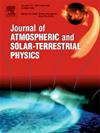Latitudinal range of geospace currents inferred from correlation matrix analysis of ground magnetic variations during magnetic storms
IF 1.8
4区 地球科学
Q3 GEOCHEMISTRY & GEOPHYSICS
Journal of Atmospheric and Solar-Terrestrial Physics
Pub Date : 2025-03-15
DOI:10.1016/j.jastp.2025.106488
引用次数: 0
Abstract
In recent years, remote sensing of magnetospheric and ionospheric currents using magnetometer arrays has improved considerably in geographic coverage, precision, and time resolution. Magnetic measurements have been used to detect and interpret a wide range of processes such as convection, solar wind (SW) compressions, substorms, magnetic storms (MSs), and more localized effects such as traveling ionospheric vortices, waves, etc. It is important to develop time- and frequency-domain methods that take advantage of these new observational capabilities. Here we apply a basic, but powerful correlation-based method for measuring the location and width of geospace current over a wide geomagnetic-latitude range. We compute the correlation matrix of the horizontal component of the magnetic field and use the structure of the matrix to measure the spatial extent of three current types. The method is applied to two recent, well-known magnetic-storm intervals (March 2015 and August 2018; 27 days each) as well as pre-storm activity intervals; but can be adapted to shorter time intervals by using higher time-resolution field data. We find that the correlation matrix is divided into three blocks, or geomagnetic latitudinal ranges, which are readily understood in terms of the footprint of the ring current, auroral electrojets, and polar convection intensifications. The matrix structure changes depending on intensity and pattern of geomagnetic activity (before, during and after the storm), and magnetic local time (MLT) range, with direct physical interpretation. The high correlations in each region are a quantitative measure of magnetospheric coherence. The results show how the correlation-matrix analysis can be used in quantitative remote sensing of spatial and temporal features of geospace activity.
由磁暴期间地磁变化的相关矩阵分析推断地球空间电流的纬向范围
近年来,利用磁强计阵列遥感磁层和电离层电流在地理覆盖、精度和时间分辨率方面都有了很大的提高。磁测量已被用于探测和解释广泛的过程,如对流、太阳风(SW)压缩、亚暴、磁暴(MSs),以及更多的局部效应,如电离层涡旋、波等。重要的是开发利用这些新的观测能力的时域和频域方法。在这里,我们应用了一种基本的,但功能强大的基于相关的方法来测量在很宽的地磁纬度范围内的地球空间电流的位置和宽度。我们计算了磁场水平分量的相关矩阵,并利用矩阵的结构测量了三种电流类型的空间范围。该方法应用于最近两次众所周知的磁暴间隔(2015年3月和2018年8月;(各27天)以及风暴前活动间隔;但可以通过使用更高时间分辨率的现场数据来适应更短的时间间隔。我们发现相关矩阵被划分为三个块,或地磁纬度范围,这很容易理解环电流足迹,极光电喷流和极地对流增强。矩阵结构的变化取决于地磁活动的强度和模式(风暴前、风暴中和风暴后)以及磁地方时(MLT)范围,具有直接的物理解释。每个区域的高相关性是磁层相干性的定量度量。结果表明,相关矩阵分析方法可用于地球空间活动时空特征的定量遥感。
本文章由计算机程序翻译,如有差异,请以英文原文为准。
求助全文
约1分钟内获得全文
求助全文
来源期刊

Journal of Atmospheric and Solar-Terrestrial Physics
地学-地球化学与地球物理
CiteScore
4.10
自引率
5.30%
发文量
95
审稿时长
6 months
期刊介绍:
The Journal of Atmospheric and Solar-Terrestrial Physics (JASTP) is an international journal concerned with the inter-disciplinary science of the Earth''s atmospheric and space environment, especially the highly varied and highly variable physical phenomena that occur in this natural laboratory and the processes that couple them.
The journal covers the physical processes operating in the troposphere, stratosphere, mesosphere, thermosphere, ionosphere, magnetosphere, the Sun, interplanetary medium, and heliosphere. Phenomena occurring in other "spheres", solar influences on climate, and supporting laboratory measurements are also considered. The journal deals especially with the coupling between the different regions.
Solar flares, coronal mass ejections, and other energetic events on the Sun create interesting and important perturbations in the near-Earth space environment. The physics of such "space weather" is central to the Journal of Atmospheric and Solar-Terrestrial Physics and the journal welcomes papers that lead in the direction of a predictive understanding of the coupled system. Regarding the upper atmosphere, the subjects of aeronomy, geomagnetism and geoelectricity, auroral phenomena, radio wave propagation, and plasma instabilities, are examples within the broad field of solar-terrestrial physics which emphasise the energy exchange between the solar wind, the magnetospheric and ionospheric plasmas, and the neutral gas. In the lower atmosphere, topics covered range from mesoscale to global scale dynamics, to atmospheric electricity, lightning and its effects, and to anthropogenic changes.
 求助内容:
求助内容: 应助结果提醒方式:
应助结果提醒方式:


